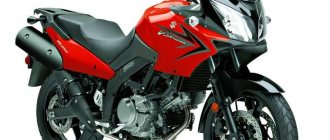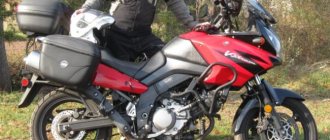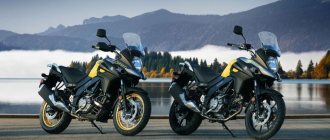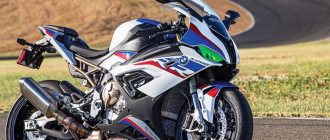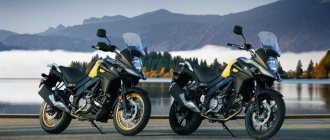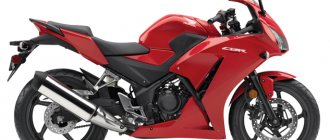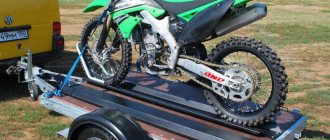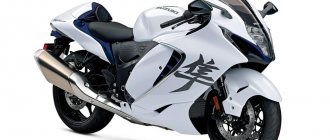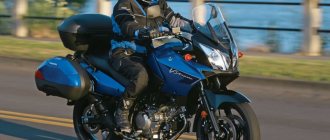The popularity of touring enduros has grown greatly since the appearance of the first bold serial experiments on rally-raid mastodons in the late 80s. Initially, tourenduros were for a long time considered a technique for a narrow circle of consumers. The Suzuki V-Strom family managed to jump into the departing carriage, standing on a par with the elders of the genre. Despite the lack of a motorcycle racing history as such, the Streams, thanks to their distinctly isolated focus on long asphalt runs and ease of everyday use, have acquired a good reputation and are still in price.
First generation (2002–2011)
The “construction” was started practically from scratch. The Japanese engineers' previous experience with big rogues was the bone-crushing DR800. The tech cocktail with the DL1000 index turned out to be quite explosive: in an aluminum frame of the original design with a removable aluminum rear subframe, a V-shaped twin borrowed from Suzuki TL sportbikes was installed with four valves per cylinder, an SDTV system (two rows of throttle valves), an injection power system, and chains in the mechanism valve timing, liquid cooling and a six-speed gearbox. The power unit was “squeezed” to 98 hp. With. at 7400 rpm and 101 Nm at 6400 rpm to get more thrust at low and mid speeds. Some kinship with sports motorcycles allowed Suzuki to quite reasonably designate the Suzuki V-Strom as a “sport enduro tourer” according to its internal classification. The first “liters” went on sale in 2002.
The appearance of the V-Strom is one of the most memorable... Suzuki usually doesn’t do it any other way! A large number of plastic parts deliberately create many edges and sharp corners. The double headlight, which occupies the entire front part of the motorcycle, adds impressiveness and solidity to the image.
The Suzuki DL1000 V-Strom suspensions are close to their purely road counterparts. The front part uses a telescopic fork with a stay diameter of 43 mm, a stroke of 160 mm and adjustable preload; at the rear there is a monoshock absorber with a stroke of 162 mm, adjustable spring preload and rebound damping. The ground clearance in fact turned out to be quite small. Therefore, it will not be possible to climb particularly far into the pampas, even if you want to. The braking system used on all first-generation motorcycles is not particularly progressive. Twin-piston calipers with 310 mm discs at the front and single-piston calipers with 260 mm discs at the rear work to the limit. Installing reinforced lines and “evil” pads on a newly purchased motorcycle is a normal practice for a “steer guide”.
In the 2000s, as a result of the partnership between Suzuki and Kawasaki, not only Intruder/Vulcan choppers were introduced, but also touring enduros. A complete analogue of the Litroström from Kawasaki is called Kawasaki KLV1000. The motorcycle was produced from 2004 to 2006. It differs from the prototype only in name.
In 2003, the DL1000 V-Strom receives a modified clutch basket and seat with a new, more comfortable profile, the front fork has the ability to adjust the spring preload, and the generator power increases from 350 to 400 W. Another year later, in 2004, in parallel with the transition of the ECU from 16 bits to 32 bits, a small liquid crystal screen appears in the instrument panel, the design of the windshield is complemented by a simple height adjustment mechanism, mirrors are also updated, wind protection for hands (becomes tougher due to fastening at two points ) and direction indicators. At the same time, the engineers reconfigured the gearbox, modified the gear shift mechanism and added an emergency light to the left control panel. To gain some ground clearance, from 2004 all DL1000s have been fitted with a plastic engine guard with a flatter bottom edge. That same year, a new branding style of plastic decals was distributed across the entire Suzuki range, including the V-Strom. The flat “Suzuki” inscription is replaced by a convex letter “S”. Since 2005, the frame color changes from silver to black, and the head light turns on automatically. Since 2006, more efficient oil injectors have been installed in the engine. In the same year, the manufacturer solved the problem of the clutch release cylinder by forcibly installing a boot on it. Subsequently, the modernized parts were added to the catalog for all years of production of the “liter”. In 2007, the direction indicator glasses were replaced with transparent ones.
Production of the first generation DL1000 V-Strom ceased in 2007, but sales continued in some countries until 2011.
Suzuki V-Strom 1000 – TEST
2014 onwards, 1037 cm3, 99 hp,
228 kg, 210 km/h, RUB 539,900.
text: Vladimir Zdorov
photo: Evgeny Bobrikov
In the photo: Vladimir Zdorov
>>The world of large touring enduros is diverse and amazes with the sophistication of its representatives, who, in the endless arms race, have long and firmly “settled” at around 150 hp. And some particularly advanced examples can easily ruin the nerves of more than one owner of a sportbike on the track!.. Just like there are specialists in the field of off-road, in the case of an experienced pilot they are quite capable of quickly moving on real off-road conditions. However, not all manufacturers strive to keep up with fashion - in particular, the management of the Suzuki concern has its own vision of the concept of a flagship touring enduro, which was implemented in a slightly different format than its competitors... In the V-Strom 1000 format
Out of format
The synergy of the big name does not correlate with reality: 99 hp. in the context of modern ecophobia, this is a very relative value. Stifled to meet the increasingly stringent requirements of the “green” engines, the V-Strom engine is unlikely to capture the imagination of even very moderate, if you like, conservative motorcyclists. The situation is approximately the same with the new design - although it noticeably moves the car away from the retro forms of its predecessor, created before the October Revolution, but it is unlikely to deserve an Oscar in the “Best Design” category. With great desire and imagination, you can see parallels in the past with such a legendary motorcycle as the SuzukiDR750, also known as “Doctor Big,” but, alas, that’s where all the space-time bridges end.
However, there is no point in discussing the mistakes of marketers: the new V-Strom was deliberately created in exactly this format. In fact, this is a large touring motorcycle, or more precisely, a completely road motorcycle, designed as an enduro for touring. So that future owners have no illusions about its off-road potential, just look at the pampered asphalt wheels, so similar to those on Suzuki sportbikes of the early 2000s, which, by the way, easily take on various geometric shapes even on the streets of the capital. The complex shapes of the exhaust system in cooperation with the oil filter, causing concern for its safety even when in contact with a small curb, are also some kind of overture, but not off-road.
Among the pleasant and new things worth noting are two-level traction control, a low seat for an enduro (850 mm), a very comfortable driver’s position, Brembo radial brake calipers and 310 mm diameter discs (oh, Gods, it looks like Atlantis has been resurrected somewhere, and Suzuki has appeared a model with quite adequate, effective braking mechanisms, which feel like they work much better than on most of the company’s sportbikes!). The impression is slightly spoiled only by the scanty and frail windshield, which is not saved even by the possibility of adjustment in three positions. As usual, there is a solution - a higher fairing, for additional euros...
The old and not at all kind engine in the past, which Suzuki has been mercilessly exploiting since 1997, in its best times produced 135 hp when it was installed in the SuzukiTL1000R frame. However, in modern reading, the engine is no longer the same. Despite a slight increase in displacement (from 998 cm3 to 1037 cm3) due to a slightly larger cylinder diameter, as much as 36 hp were mercilessly sacrificed to “His Majesty the Torque.” Not without a heavier stator, “humble” camshafts and other inquisitorial essays from the engineers.
Indeed, a solid torque makes itself felt already from 3,500 rpm... but all this riot and extravaganza of acceleration colors ends already at 5,500 rpm! Everything that follows is a sad contemplation of beauty... Show me a modern large-capacity touring enduro that “dies” after 170 km/h and barely reaches the speedometer up to 210 km/h? Although, what am I talking about? That's right - for 99 hp. the results are quite expected...
But if you abstract from a priori unpromising comparisons with the Top line of other manufacturers and try to plunge into the philosophy of Suzuki, then everything will fall into place. The engine of the new V-Strom is in complete harmony with the precision-tuned chassis: no, no electronic suspension adjustments, like much more expensive opponents, are offered on the V-Strom 1000 even as an option, but... they are not needed. Firstly, for particularly offensive “athletes”, it is possible to adjust the suspension in the good old mechanical way. And, secondly, even in stock, the motorcycle has a very collected, Nordic behavior on the road, more likely reminiscent of a good naked bike than a larger enduro.
Taking into account the fact that already after 3,500 rpm the driver has more than 80% of the total torque at his disposal, you can “hang” in sixth gear after reaching 80 km/h and forget about switching for a long time. It is important to note that this nature of the power plant allows you to almost not notice the additional load in the form of a passenger and luggage - if we talk about a motorcycle from a tourism point of view, then this is certainly a valuable quality. By the way, one of the definite advantages is the amazing efficiency of the V-Strom: even the most aggressive driving style did not allow me to “make” more than 8 liters per 100 km! If you move in the modes in which most sane travelers travel, then it is quite possible to get something in the region of 6 l/100 km...
Perception
So, what did the Japanese, as wise as three dozen owls, finally put together under the new name Suzuki V-Strom 1000? Budget (yes, first of all, it’s really the most “tasty” option among opponents in price, “killing” even KawasakiVersus!), comfortable (especially if you replace the standard bikini fairing), with good handling, a motorcycle capable of long trips on asphalt in enduro form. Why “in character”? Because no matter how much and how you attach off-road tuning to a motorcycle, the whole thing will rest on alloy wheels (the company does not offer spoked options at the time of publication). In other words, as soon as such an option appears, it will be possible to talk about a more accurate fit into the term “enduro”. True, no one can cancel a modest ground clearance and an oil filter along with pipes dangerously close to the ground.
To the quite reasonable remark that 99% of V-Strom 1000 owners will travel exclusively on asphalt, it is quite reasonable to note that the same Suzuki has much more interesting models for traveling on asphalt. By the way, with a quite comparable price. Yes, the model can be equipped with all the accessories of a real off-road master and, if desired, even come up with something with spoked wheels... This version of the V-Strom will be called... BMWR1200GS / YamahaXTZ1200 / HondaVFR1200XCrosstourer / KTM 1190 Adventure (underline as appropriate). The price will be something similar, only minus the hemorrhoids and the time it takes to install all the necessary ingredients.
Despite the technical complexity of implementation, Suzuki uses a dual ignition system in the V-Strom motorcycle engine. A gasoline internal combustion engine works by igniting the fuel-air mixture, and the spark plugs are responsible for “igniting the conflict.” A standard spark plug works due to a voltage pulse with an amplitude of ~25 kV and a duration of ~1–2 ms applied to its electrodes. The high temperature of the spark discharge plasma ensures local ignition of the fuel mixture and forms a flame front moving through the combustion chamber. In turn, the flame front is a narrow zone of the medium, without sharply defined boundaries, in which combustion occurs. The thickness of such a layer, taking into account the pressure in the cylinder, is a fraction of a millimeter. Thus, if we decompose the process of explosion of the fuel-air mixture in an engine cylinder in time, we can see that at each moment combustion occurs only in a small part of the chamber, exerting an asymmetrical effect on its walls, which creates additional losses due to the “shifting” of the piston. To optimize combustion geometry, engineers use complex mathematical models and measurement systems when designing engines—for example, special spark plugs with fiber-optic sensors that allow them to “look” inside a running engine. On some production engines, Suzuki uses a rather simple but effective method: by installing a second spark plug in the combustion chamber and applying a high-voltage pulse to it with a slight delay relative to the first, you can obtain a flame front that is close to symmetrical, which reduces losses in the cylinder-piston group and increases combustion efficiency fuel. An additional advantage of this approach is increased reliability of the ignition system. If the spark plug, ignition coil or output transistor of the engine control unit fails, the cylinder will continue to operate, and the driver will notice the malfunction only thanks to the Check Engine indicator. The use of a similar engineering solution on the Suzuki V-Strom provides approximately a 5% increase in power - this is not difficult to verify by using a dynamometer and temporarily disconnecting the second spark plug.
Second generation (2013 – present)
Suzuki DL1000 V-Strom in 2013 was resurrected like a phoenix. Moreover, in a new interpretation. The motorcycle, with unchanged fundamental technical solutions, has changed in almost every detail. Of course, the first thing that catches your eye is the appearance. “Ström” is beautiful, but not as recognizable as before. This is due to the transition from two separate headlights to one medium-sized oval one a la Suzuki GSX-R, from which a very funny sharp bird's beak rushes forward. The amount of plastic on the motorcycle has been radically reduced. Thus, the silhouette was cut into separate parts - the tail was released, due to the fact that the exhaust “can” moved downwards, the tubular rear subframe became visible. According to Suzuki designers, when creating the image of the new “liter”, they took inspiration from the old Suzuki DR750S from 1988.
The frame is still an aluminum diagonal structure. But now it is already in the middle part and 13% lighter. The new two-cylinder engine with a 90° cylinder angle, liquid cooling, two spark plugs with individual coils (the system appeared only in the second generation) and four valves per cylinder has gained a little meat compared to its predecessor. The working volume increased to 1037 cm3, peak power increased to 100 hp. With. at 8000 rpm, the electronics settings and the ignition system have changed. The oil cooler in the cooling system had to be sacrificed to reduce weight without compromising performance. The volume of the fuel tank was reduced to 20 liters. The range of electronic assistants has expanded significantly. Electronic two-level traction control was added to the already existing ABS system (for the first time on Suzuki motorcycles). The Ride-by-wire system, which is already standard on modern motorcycles, is not available on the 2014–2016 DL1000. The Japanese remained faithful to the dual throttle system, adding more efficient injectors to it. The first row of dampers is controlled through cables by the throttle handle, the second row is controlled by an electronic unit through a servo drive. An electronically controlled boost valve (ECM) has been added to the exhaust system. The clutch is still hydraulically driven and has a superstructure in the form of a SCAS (Suzuki Clutch Assist System) control system. The sixth stage in the gearbox has become much longer.
The engineers stuffed the suspension of the new “liter” with all the necessary adjustments as much as possible, due to the lack of Suzuki electronic systems that allow you to change settings on the fly, and did not forget about modern trends. That is why the second generation motorcycle is equipped with an impressive fully adjustable Kayaba “upside-down” with a 43 mm diameter of stays and a modern monoshock absorber on progression links with rebound adjustment and preload adjustment located on a separate large “twist”. The rear aluminum swingarm is lengthened by 26 mm (base 1555 mm), the fork rake is reduced to 25°. With a similar chassis geometry, the motorcycle turned out to be very nimble and obedient.
The braking system is also a local revolution. The long-awaited Tokico four-piston radials are mounted on the front wheel along with 310 mm discs. At the rear, as before, there is a single-piston Nissin caliper and a 260 mm disc. An anti-lock braking system using Bosh components is part of the standard equipment. The wheel sizes are the same – 110/80–19 and 150/70–17.
Nice additions include an adjustable windshield in height and angle (six possible positions in total), a 12 V socket and a dashboard with an on-board computer and a gear indicator.
Specifications
| Model | Suzuki DL1000 V-Strom |
| Motorcycle type | touring enduro |
| Year of issue | 2002+ |
| Frame | aluminum diagonal |
| engine's type | 2-cylinder, 4-stroke, V-shaped (L-shaped) |
| Working volume | 996 cm³ – DL1000 (2002-2012) 1037 cm³ – DL1000 (2013+) |
| Bore/Stroke | 98.0 x 66.0 mm – DL1000 (2002-2012) 100.0 x 66.0 mm – DL1000 (2013+) |
| Compression ratio | 11.3:1 |
| Cooling | liquid |
| Number of valves per cylinder | DOHC, 4 valves per cylinder |
| Fuel supply system | injector with SDTV - Suzuki Dual Throttle Valve, 2x 45 mm |
| Ignition type | transistor |
| Maximum power | 98.0 hp (72.0 kW) at 7500 rpm - DL1000 (2002-2012) 101.0 hp (74.0 kW) at 8500 rpm – DL1000 (2013+) |
| Maximum torque | 104.0 Nm (10.5 kg*m) at 6500 rpm – DL1000 (2002-2012) 101.0 Nm (10.2 kg*m) at 4000 rpm – DL1000 (2013+) |
| Transmission | 6-speed |
| type of drive | chain |
| Front tire size | 110/80 R19 M/C 59H – DL1000 110/80 R19 M/C 59V – DL1000 XT |
| Rear tire size | 150/70 R17 M/C 69H – DL1000 150/70 R17 M/C 69V – DL1000 XT |
| Front brakes | 2 discs, 310 mm, 2-piston calipers – DL1000 (2002-2012) 2 discs, 310 mm, 4-piston radial calipers, ABS – DL1000 (2013+) |
| Rear brakes | 1 disc, 260 mm, 1-piston caliper – DL1000 (2002-2012) 1 disc, 260 mm, 1-piston caliper, ABS – DL1000 (2013+) |
| Front suspension | 43 mm Showa telescopic fork (non-adjustable), 160 mm travel – DL1000 (2002) 43 mm Showa telescopic fork (preload adjustable), travel - 160 mm - DL1000 (2003-2012) 43mm KYB inverted fork (fully adjustable), 160mm travel – DL1000 (2013+) |
| Rear suspension | pendulum with monoshock absorber (adjustable preload and rebound), stroke - 159 mm - DL1000 (2002-2012) pendulum with monoshock absorber (adjustable preload and rebound), stroke - 160 mm - DL1000 (2013+) |
| Motorcycle length | 2295 mm – DL1000 (2002-2012) 2280 mm – DL1000 (2013+) |
| Motorcycle width | 865 mm – DL1000 (2002-2003) 910 mm – DL1000 (2004-2012) 930 mm – DL1000 (2013+) |
| Motorcycle height | 1335 mm – DL1000 (2002-2003) 1395 mm – DL1000 (2004-2012) 1470 mm – DL1000 (2013+) |
| Wheelbase | 1535 mm – DL1000 (2002-2012) 1555 mm – DL1000 (2013+) |
| Seat height | 840 mm – DL1000 (2002-2012) 850 mm – DL1000 (2013+) |
| Minimum ground clearance (clearance) | 165 mm |
| Acceleration to 100 km/h | 3.61 sec – DL1000 (2002-2012) 3.02 sec – DL1000 (2013+) |
| Maximum speed | 199 km/h – DL1000 (2002-2012) 214 km/h – DL1000 (2013+) |
| Gas tank capacity | 22.0 l – DL1000 (2002-2012) 20.0 l – DL1000 (2013+) |
| Motorcycle weight (dry) | 207 kg – DL1000 (2002-2003), DL1000 XT 208 kg – DL1000 (2004+) |
First generation (2004–2011)
A smaller copy of the flagship liter launched with a two-year delay in 2004. The power unit is a redesigned and almost not deformed (loss of only 3 hp) version of the “two” from the SV650. The main design differences from the “liter” are in the displacement, camshafts, crankshaft with inertia increased by 4%, filter box and exhaust design. The working surface of the cylinders, as in the case of the DL1000, is coated with a patented SCEM composition based on nickel, phosphorus, carbide and silicon. This coating has similar characteristics to nikasil. In the donor SV-hi engine, cast iron liners were used. The power system, similar to its older brother, uses two rows of throttle valves. The cooling system is tied to two radiators.
What is characteristic is that the “650” is absolutely not inferior to the “liter” in terms of tactical and technical characteristics. Quite the contrary. With similar dynamics, the DL650 is much more interesting in terms of maneuverability and fuel consumption (4–7 liters in city mode versus 8–12 liters for the DL1000). However, with maximum load on the 650, there is no power reserve of 140–150 km/h at all. “Pushing” the device over 150 km/h becomes an impossible task. The liter version overcomes these difficulties in one go.
If we think in big pictures, then from a distance the “650” clearly differs from the “liter” in one “can” of the exhaust system on the right side (the DL1000 has two of them), the absence of a plastic plow under the engine, the absence of gills on the side plastic in the area of the engine and protective mugs on the steering wheel, as well as nameplates and some small parts. Otherwise, the first generation motorcycles are indistinguishable.
As part of the first generation, the V-Strom 650 was gradually modernized throughout its eight years. So in 2005, the head light began to turn on automatically after turning the ignition key. In 2007, an anti-lock brake system appeared on the list of options, the engine received an ignition system with two spark plugs for each cylinder, and the wheelbase increased to 1560 mm due to an increase in the length of the pendulum by 15 mm. In the same year, the idle air control screw was abolished in the intake system in favor of electronics. In 2008, the generator power was increased from 375 W to 400 W. Throughout 2010, the Suzuki V-Strom 650 was not sold in the US market. In 2011, sales resumed, and ABS became part of the standard equipment.
The 650 is largely a copy of its liter counterpart. The only differences are in the engine, electronics, attachments and suspension presets. An important feature of the DL650 is its absolutely problem-free (which cannot be said about the DL1000) cable clutch drive.
Brief history of the model
2002 - start of production and sales of the model. Model: Suzuki V-Strom 1000 (all markets). Factory designation: DL1000K2.
2003 - the front fork gets preload adjustment, the shape of the seat and the clutch basket change. The hydraulic clutch cylinder receives a new dust cover, and the generator power increases from 350 to 400 W. Model: Suzuki V-Strom 1000 (all markets). Factory designation: DL1000K3.
2004 - The model receives new mirrors, a new instrument panel, a more advanced windshield height adjustment mechanism and hand wind protection as standard. The 16-bit control unit (ECU) is changed to 32-bit. New turn signals (20 W, without reflector). American versions get high beam blinkers and emergency lights (European versions already had this). Model: Suzuki V-Strom 1000 (all markets). Factory designation: DL1000K4.
2005 - The model receives a new clutch cover and headlights that turn off when the starter is running. Model: Suzuki V-Strom 1000 (all markets). Factory designation: DL1000K5.
2006 - the model receives modified oil nozzles. Model: Suzuki V-Strom 1000 (all markets). Factory designation: DL1000K6.
2007 - the model receives new turn signals (clear glass) and new rear progression elements. Model: Suzuki V-Strom 1000 (all markets). Factory designation: DL1000K7.
2008 - no significant changes. Model: Suzuki V-Strom 1000 (all markets). Factory designation: DL1000K8.
2009 - no significant changes. Model: Suzuki V-Strom 1000 (all markets). Factory designation: DL1000K9.
2010 - no significant changes. Model: Suzuki V-Strom 1000 (all markets). Factory designation: DL1000L0.
2011 - no significant changes. Model: Suzuki V-Strom 1000 (all markets). Factory designation: DL1000L1.
2012 - no significant changes. Model: Suzuki V-Strom 1000; Suzuki V-Strom 1000 ABS (all markets). Factory designation: DL1000L2; DL1000AL2.
2013 - restyling of the model. The model gets a new appearance, a new dashboard design, a new frame (13% lighter), a new engine (volume increased to 1037 cm³, maximum power - 101 hp), a new braking system (front 4-piston radial calipers) , ABS in the standard version, new fork (inverted type, all adjustments), engine traction control system, fuel tank reduced from 22 to 20 liters, 2-in-1 exhaust system. Model: Suzuki V-Strom 1000 ABS (all markets). Factory designation: DL1000AL3.
2014 - no significant changes. Model: Suzuki V-Strom 1000 ABS (all markets). Factory designation: DL1000AL4.
2015 - no significant changes. Model: Suzuki V-Strom 1000 ABS (all markets). Factory designation: DL1000AL5.
2016 - no significant changes. Model: Suzuki V-Strom 1000 ABS (all markets). Factory designation: DL1000AL6.
2017 - the appearance of the XT modification with spoked wheels. Model: Suzuki V-Strom 1000 ABS; Suzuki V-Strom 1000 XT (all markets). Factory designation: DL1000AL7; DL1000XAL7.
2018 - no significant changes. Model: Suzuki V-Strom 1000 ABS; Suzuki V-Strom 1000 XT (all markets). Factory designation: DL1000AL8; DL1000XAL8.
